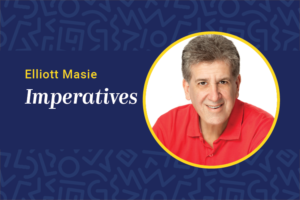There’s a shift happening in the learning field of fewer full-time learning and development employees delivering programs to their own staff.
by Elliott Masie
August 17, 2017

There’s a shift happening in the learning field that is easy to notice. I see significantly fewer full-time learning and development employees delivering programs to their own staff.
In some organizations, the number of L&D professionals has dropped by as much as 80 percent. Yet, there is actually more learning happening than ever before. So what is happening to our field and what lies ahead for learning as an organizational function?
Here are several elements that have collectively led to a smaller number of full-time L&D employees:
Reduction in face-to-face classes: A large number of learning folks used to be called “trainers” in “training departments.” They were subject matter experts who had a passion for classroom delivery. We brought them into the learning function for a few years or for long careers as teachers. The total number of internally led classes has dropped, replaced by asynchronous e-learning or by webinars that are delivered virtually. In those cases, SMEs are still being used but they are borrowed for that function while keeping their line jobs.
Learning roles in the business units vs. L&D groups: In areas that have high levels of turnover such as retail, sales and front-line roles, there are larger numbers of learning colleagues with jobs that are located in a line of business or function. They often have a modifier to describe their learning responsibility such as sales readiness manager or field leader for induction. They may have a dotted-line connection to the L&D department but often see their careers aligning with another business function. As a result, they are less likely to identify themselves primarily as learning professionals.
External sourcing of learning development: The number of internal instructional designers has also dropped significantly. A large percentage of asynchronous content is being designed and developed under contract by external providers or licensed from a content supplier or industry association. In some companies the on-site instructional designers may be brought in for a specific project rather than added to the learning team.
Learning that does not sound like learning: One large manufacturing company has a team that creates short video clips focused on recent safety problems or challenges. The team is called Maximize and does not contain any learning professionals; yet it is deeply involved in content and activity development. I met with one of this team’s leaders who said that they don’t use words like “objective” or “outcome” because they are in what this leader called the “social knowledge space.” The future of learning will include more embedded content and context than traditional courses.
Skill gaps in learning: A big challenge is the need for a new set of skills. There is an enormous need for expertise in data analytics, curation of learning content, performance and workflow support, and user experience design.
Glass ceilings: There are significant limits that constrain the long-term career opportunities for current and future learning professionals. Some of these are titles (e.g. instructional designer) that describe competencies but do not suggest the ability to perform other functions. I like to use the title “learning producer,” which has a wider set of future options. In addition, many learning professionals are perceived as lacking hard business skills. This can be corrected with stretch assignments in business roles and by shifting college programs to include more content on career enablers like business performance rather than learning strategies and models like ADDIE.
It is time for the learning field to have a deep and open conversation about how we re-engineer our craft, our skills and our careers. The workforce and our world need agile, innovative and business-aligned learning colleagues to face the changing workplace of the future. Let’s step up to the challenge.
Elliott Masie is the chairman and CLO of The Masie Center’s Learning Consortium and CEO of The Masie Center, an international think tank focused on learning and workplace productivity. To comment, email editor@CLOmedia.com.




